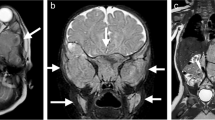Abstract
Epidural neuroblastoma xenografts in nude rats causing paraparesis were treated with intravenous injection of an anti-GD2 monoclonal antibody 3F8. Metastatic or primary epidural tumors in humans cause rapid neurologic compromise. Treatment is often unsatisfactory. An animal model was established to study antibody targeted therapy of epidural tumor. Human neuroblastoma was xenotransplanted into the thoracic epidural space of nude rats. When paraparesis developed, animals were treated intravenously with an anti-GD2 monoclonal antibody, 3F8, either alone or radiolabeled with131Iodine. Improvement in neurologic function occurred in 2 of 20 (10%) animals receiving no treatment or control antibody, 14 of 17 (82%) animals receiving 3F8 alone and all 9 animals receiving131I-3F8 (p<0.0001 for 3F8 or131I-3F8 vs. control). Six animals treated with 3F8 alone recovered normal neurologic function and remained well until sacrifice 10 days later. Four animals treated with 3F8 alone had no tumor evident on pathologic examination. The percent injected dose of131I-3F8/g tumor in 5 samples ranged from 0.73% to 3.8%. These observations demonstrate that neoplastic epidural compression of the spinal cord in the rat can be treated successfully with intravenous unmodified monoclonal antibody and that signs of neurologic dysfunction can be reversed. The potential of this approach in treating patients with epidural tumors and other neoplasms, especially those that are not sensitive to chemotherapy or radiotherapy, deserves to be explored.
Similar content being viewed by others
References
Gilbert RW, Kim JH, Posner JB: Epidural spinal cord compression from metastatic tumor: diagnosis and treatment. Ann Neurol 3: 40–51, 1978
Klein SL, Sanford RA, Muhlbauer MS: Pediatrie spinal epidural metastases. J Neurosurg 74: 70–75, 1991
Findlay GF: Adverse effects of the management of malignant spinal cord compression. J Neurol Neurosurg Psychiatry 47: 761–768, 1984
Kaminski HJ, Diwan VG, Ruff RL: Second occurrence of spinal epidural metastases. Neurology 41: 744–746, 1991
Boogerd W, van der Sande JJ, Kroger R, Bruning PF, Somers R: Effective systemic therapy for spinal epidural metastases from breast carcinoma. Eur J Cancer Clin Oncol 25(1): 149–153, 1989
Hayes FA, Thompson EI, Hvizdala E, O'Connor D, Green AA: Chemotherapy as an alternative to laminectomy and radiation in the management of epidural tumor. J Pediatr 104: 221–224, 1984
Ushio Y, Posner R, Kim JH, Shapiro WR, Posner JB: Treatment of experimental spinal cord compression caused by extradural neoplasms. J Neurosurg 47: 380–390, 1977
Press OW, Eary JF, Badger CC, Martin PJ, Appelbaum FR, Levy R, Miller R, Brown S, Nelp WB, Krohn KA: Treatment of refractory non-Hodgkin's lymphoma with radiolabeled MB-1 (anti-CD37) antibody. J Clin Oncol 7:1027–1038, 1989
Cheung NK, Burch L, Kushner BH, Munn DH: Monoclonal antibody 3F8 can effect durable remissions in neuroblastoma patients refractory to chemotherapy: a phase II trial. In: Evans AE (ed) Advances in Neuroblastoma Research 3: 395–400, 1991
Cheung N-KV, Landmeier B, Neely J, Nelson AD: Complete tumor ablation with iodine 131-radiolabeled disialoganglioside GD2-specific monoclonal antibody against human neuroblastoma xenografted in nude mice. J Natl Cancer Inst 77(3): 739–745, 1986
Lee YS, Bullard DE, Zalutsky MR, Coleman RE, Wikstrand CJ, Friedman HS, Colapinto EV, Bigner DD: Therapeutic efficacy of antiglioma mesenchymal extracellular matrix 131-radiolabeled murine monoclonal antibody in a human glioma xenograft model. Cancer Res 48: 559–566, 1988
Yeh SD, Larson SM, Burch L, Kushner BH, Laquaglia M, Finn R, Cheung NK: Radioimmunodetection of neuroblastoma with iodine-131-3F8: correlation with biopsy, iodine-131-metaiodobenzylguanidine and standard diagnostic modalities. J Nucl Med 32: 769–776, 1991
Larson SM, Cheung NK, Leibel S: Antibodies in cancer therapy: basic principles of monoclonal antibodies — Radioisotope conjugates. In: DeVita VT, Hellman S, Rosenberg SA (ed) Biologic Therapy of Cancer, J.B. Lippincott Co, Philadelphia, PA 496–511
Delattre JY, Arbit E, Thaler HT, Rosenblum MK, Posner JB: A dose-response study of dexamethasone in a model of spinal cord compression caused by epidural tumor. J Neurosurg 70: 920–925, 1989
Liao SK, Clarke BJ, Kwong PC, Brickenden A, Gallic BL, Dent PB: Common neuroectodermal antigens on human melanoma, neuroblastoma, retinoblastoma, glioblastoma and fetal brain revealed by hybridoma antibodies raised against melanoma cells. Eur J Immunol 11: 45–454, 1981
Fridman R, Kibbey MC, Royce LS, Zain M, Sweeney M, Jicha DL, Yannelli JR, Martin GR, Kleinman HK: Enhanced tumor growth of both primary and established human and murine tumor cells in athymic mice after coinjection with matrigel. J Natl Cancer Inst 83: 769–774, 1991
Miraldi FD, Nelson AD, Kraly C, Ellery S, Landmeier B, Coccia PF, Strandjord SE, Cheung NK: Diagnostic imaging of human neuroblastoma with radiolabeled antibody. Radiology 161:413–418, 1986
Cheung NK, Neely JE, Landmeier B, Nelson D, Miraldi F: Targeting of ganglioside GD2 monoclonal antibody to neuroblastoma. J Nucl Med 28:1577–83, 1987
Tarlov IM: Spinal cord compression studies. Time limits for recovery after gradual compression in dogs. Arch Neurol Psychiatry 71: 588–597, 1954
Azar HA, Fernandez SB, Bros LM, Specter SC: Human tumor xenografts in nude mice: current experience and chemotherapy trials. Pathol Ann 19(Pt2): 245–268, 1984
Capone PM, Papsidero LD, Croghan GA, Chu TM: Experimental tumoricidal effects of monoclonal antibody against solid breast tumors. Proc Natl Acad Sci 80:7328–7332, 1983
Catane R, Longo DL: Monoclonal antibodies for cancer therapy, Isr. J Med Sci 24: 471–476, 1988
Houghton AN, Mintzer D, Cordon-Cardo C, Welt S, Fliegel B, Vadhan S, Carswell E, Melamed MR, Oettgen HF, Old LJ: Mouse monoclonal IgG3 antibody detecting GD3 ganglioside: a phase I trial in patients with malignant melanoma. Proc Natl Acad Sci USA 82:1242–1246, 1985
Schulz G, Staffileno LK, Reisfeld RA, Dennert G: Eradication of established human melanoma tumors in nude mice by antibody-directed effector cells. J Exp Med 161: 1315–1325, 1985
Cheung NKV, Medof ME, Munn D: Immunotherapy with GD2 specific monoclonal antibodies. Advances in neuroblastoma research 2: 619–632, 1988
Author information
Authors and Affiliations
Rights and permissions
About this article
Cite this article
Bergman, I., Arbit, E., Rosenblum, M. et al. Treatment of spinal epidural neuroblastoma xenografts in rats using anti-GD2 monoclonal antibody 3F8. J Neuro-Oncol 15, 235–242 (1993). https://doi.org/10.1007/BF01050069
Issue Date:
DOI: https://doi.org/10.1007/BF01050069




